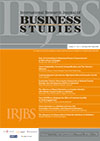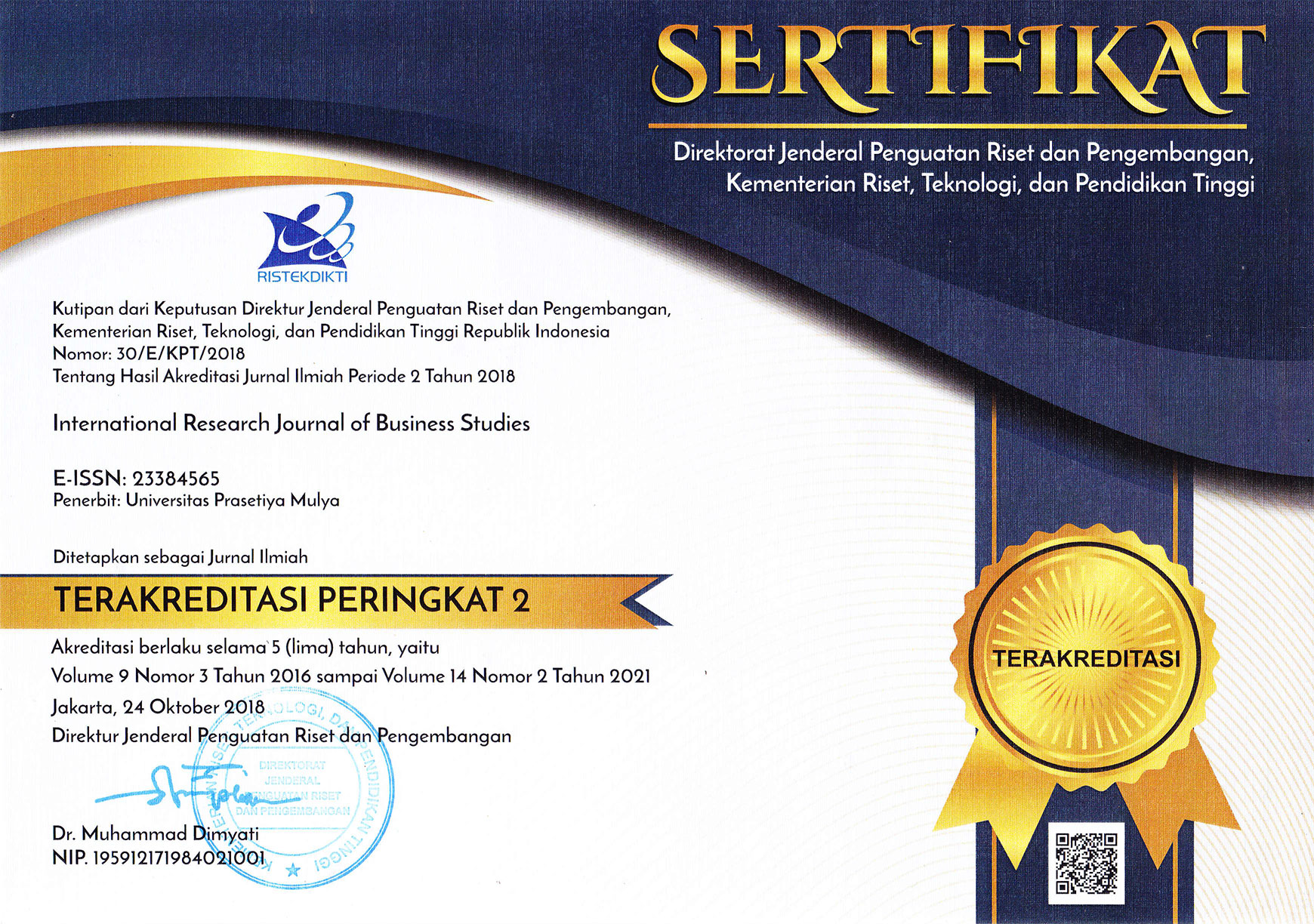CSR Practice and Asymmetry Information of Indonesian Public Listed Companies
DOI:
https://doi.org/10.21632/irjbs.11.1.45-66Keywords:
CSR, asymmetry information, environmental, social scoreAbstract
Our study examines the relationship between Corporate Social Responsibility (CSR) practice and asymmetry information in the Indonesian Stock Exchange. We conjecture that these two concepts are negatively associated. To empirically test their association, we use the availability of CSR report, environmental score, and social score as the surrogate indicators of CSR practice. While, bid/ask spread (BAS) and price volatility (PV) are employed as the proxies of Asymmetry information. Using the quarterly data spans from the second quarter of 2012 to the fourth quarter of 2016, we collect as many as 39 companies that voluntarily disclosed their CSR-related information. To investigate the importance of CSR practice in the truncation of asymmetry information, we use the univariate analysis and multivariate analysis. We find that CSR practice is negatively associated with the asymmetry information. Our results remain consistently after we control for the firm-specific, year, and industry fixed-effect.
References
Adams, C. A. (2008). A commentary on: corporate social responsibility reporting and reputation risk management. Accounting, Auditing & Accountability Journal, 21(3), 365–370. https://doi.org/10.1108/09513570810863950
Aerts, W., & Cormier, D. (2009). Media legitimacy and corporate environmental communication. Accounting, Organizations and Society, 34(1), 1–27. https://doi.org/10.1016/j.aos.2008.02.005
Alon, A., & Vidovic, M. (2015). Sustainability performance and assurance: influence on reputation. Corporate Reputation Review, 18(4), 337–352. https://doi.org/10.1057/crr.2015.17
Amran, A., Ooi, S. K., Mydin, R. T., & Devi, S. S. (2015). The impact of business strategies on online sustainability disclosures. Business Strategy and the Environment, 24(6), 551–564. https://doi.org/10.1002/bse.1837
Axjonow, A., Ernstberger, J., & Pott, C. (2016). The impact of corporate social responsibility disclosure on corporate reputation: a non-professional stakeholder perspective. Journal of Business Ethics. https://doi.org/10.1007/s10551-016-3225-4
Bagnoli, M., & Watts, S. G. (2017). Voluntary assurance of voluntary CSR disclosure. Journal of Economics and Management Strategy, 26(1), 205–230. https://doi.org/10.1111/jems.12171
Baltagi, B. H. (2008). Econometric analysis of panel data. Econometric Theory, 13(05), 351. https://doi.org/10.1017/S0266466600006150
Bebbington, J., Larrinaga-González, C., & Moneva-Abadía, J. M. (2008). Legitimating reputation/the reputation of legitimacy theory. Accounting, Auditing & Accountability Journal, 21(3), 371–374. https://doi.org/10.1108/09513570810863969
Bebbington, J., Larrinaga, C., & Moneva, J. M. (2008). Corporate social reporting and reputation risk management. Accounting, Auditing & Accountability Journal, 21(3), 337–361. https://doi.org/10.1108/09513570810863932
Beretta, S., & Bozzolan, S. (2008). Quality versus quantity: the case of forward-looking disclosure. Journal of Accounting, Auditing & Finance, 23(3), 333–376. https://doi.org/10.1177/0148558X0802300304
Bondy, K., Moon, J., & Matten, D. (2012). An institution of corporate social responsibility (CSR) in multi-national corporations (MNCs): form and implications. Journal of Business Ethics, 111(2), 281–299. https://doi.org/10.1007/s10551-012-1208-7
Botosan, C. A., & Harris, M. S. (2000). Motivations for a change in disclosure frequency and its consequences: An examination of voluntary quarterly segment disclosures. Journal of Accounting Research, 38(2), 329. https://doi.org/10.2307/2672936
Brown, H. S., de Jong, M., & Levy, D. L. (2009). Building institutions based on information disclosure: lessons from GRI’s sustainability reporting. Journal of Cleaner Production, 17(6), 571–580. https://doi.org/10.1016/j.jclepro.2008.12.009
Cho, C. H., Michelon, G., & Patten, D. M. (2012). Impression management in sustainability reports: An empirical investigation of the use of graphs. Accounting and the Public Interest, 12(1), 16–37. https://doi.org/10.2308/apin-10249
Cho, C. H., Michelon, G., Patten, D. M., & Roberts, R. W. (2015). CSR disclosure: the more things change…? Accounting, Auditing & Accountability Journal, 28(1), 14–35. https://doi.org/10.1108/AAAJ-12-2013-1549
Cho, C. H., & Patten, D. M. (2007). The role of environmental disclosures as tools of legitimacy: A research note. Accounting, Organizations and Society, 32(7–8), 639–647. https://doi.org/10.1016/j.aos.2006.09.009
Cho, C. H., & Patten, D. M. (2013). Does today’s CSR disclosure differ from the disclosure of the 1979s? An empirical analysis. In Seventh Asia Pacific Interdisciplinary Research in Accounting Conference. Kobe 26-28 July, 2013.
Cho, S. Y., Lee, C., & Pfeiffer, R. J. (2013). Corporate social responsibility performance and information asymmetry. Journal of Accounting and Public Policy, 32(1), 71–83. https://doi.org/10.1016/j.jaccpubpol.2012.10.005
Colleoni, E. (2013). CSR communication strategies for organizational legitimacy in social media. Corporate Communications: An International Journal, 18(2), 228–248. https://doi.org/10.1108/13563281311319508
Cormier, D., & Magnan, M. (2015). The economic relevance of environmental disclosure and its impact on corporate legitimacy: an empirical investigation. Business Strategy and the Environment, 24(6), 431–450. https://doi.org/10.1002/bse.1829
Dhaliwal, D. S., Li, O. Z., Tsang, A., & Yang, Y. G. (2011). Voluntary nonfinancial disclosure and the cost of equity capital:
The initiation of corporate social responsibility reporting. The Accounting Review, 86(1), 59–100. https://doi.org/10.2308/accr.00000005
Dhaliwal, D. S., Radhakrishnan, S., Tsang, A., & Yang, Y. G. (2012). Nonfinancial disclosure and analyst forecast accuracy: International evidence on corporate social responsibility disclosure. The Accounting Review, 87(3), 723–759. https://doi.org/10.2308/accr-10218
E&Y. (2017). Is your nonfinancial performance revealing the true value of your business to investors? Ey. Retrieved from http://www.ey.com/Publication/vwLUAssets/EY_-_Nonfinancial_performance_may_influence_investors/%24FILE/ey-nonfinancial-performance-may-influence-investors.pdf
Espinosa, M., & Trombetta, M. (2004). The reputational consequences of disclosures. Working Paper No. IVIE WP-EC 2004 - 10, 1–27. Retrieved from http://www.ivie.es/downloads/docs/wpasec/wpasec-2004-10.pdf
Fifka, M. S. (2013). Corporate responsibility reporting and its determinants in comparative perspective - a review of the empirical literature and a meta-analysis. Business Strategy and the Environment, 22(1), 1–35. https://doi.org/10.1002/bse.729
Hahn, R., & Lulfs, R. (2014). Legitimizing negative aspects in GRI-oriented sustainability reporting: a qualitative analysis of corporate disclosure strategies. Journal of Business Ethics, 123(3), 401–420. https://doi.org/10.1007/s10551-013-1801-4
KPMG. (2017). The KPMG Survey of Corporate Responsibility Reporting 2017. KPMG. https://doi.org/10.1038/nnano.2013.238
KPMG International. (2015). KPMG survey of corporate responsibility reporting 2015. KPMG Corporate Responsibility Reporting. https://doi.org/www.kpmg.com/sustainability
Lennox, C. S., Francis, J. R., & Wang, Z. (2012). Selection models in accounting research. The Accounting Review, 87(2), 589–616. https://doi.org/10.2308/accr-10195
Manchiraju, H., & Rajgopal, S. (2017). Does corporate social responsibility (CSR) create shareholder value? evidence from the Indian companies act 2013. Journal of Accounting Research, 55(5), 1257–1300. https://doi.org/10.1111/1475-679X.12174
Martínez-Ferrero, J., & García-Sánchez, I. M. (2016). The level of sustainability assurance: The effects of brand reputation and industry specialisation of assurance providers. Journal of Business Ethics, pp. 1–20. https://doi.org/10.1007/s10551-016-3159-x
Merkl-Davies, D. M., & Brennan, N. M. (2007). Discretionary disclosure strategies in corporate narratives : incremental information or impression management ? Journal of Accounting Literature, 26, 116–196. Retrieved from http://hdl.handle.net/10197/2907
Mertens, W., Pugliese, A., & Recker, J. (2016). Quantitative data analysis: a companion for accounting and information systems research. Quantitative Data Analysis: A Companion for Accounting and Information Systems Research. Switzerland: Springer International Pubishing Switzerland. https://doi.org/10.1007/978-3-319-42700-3
Michelon, G., Pilonato, S., & Ricceri, F. (2015). CSR reporting practices and the quality of disclosure: An empirical analysis. Critical Perspectives on Accounting, 33, 59–78. https://doi.org/10.1016/j.cpa.2014.10.003
Michelon, G., Pilonato, S., Ricceri, F., & Roberts, R. W. (2016). Behind camouflaging: Traditional and innovative theoretical perspectives in social and environmental accounting research. Sustainability Accounting, Management and Policy Journal, 7(1), 2–25. https://doi.org/10.1108/09574090910954864
Milne, M. J., & Patten, D. M. (2002). Securing organizational legitimacy: an experimental decision case examining the impact of environmental disclosures. Accounting, Auditing & Accountability Journal, 15(3), 372–405. https://doi.org/http://dx.doi.org/10.1108/BIJ-10-2012-0068
Neu, D., Warsame, H., & Pedwell, K. (1998). Managing public impressions: environmental disclosures in nnual Reports. Accounting, Organizations and Society, 23(3), 265–282. https://doi.org/10.1016/S0361-3682(97)00008-1
Nurazi, R., Kananlua, P. S., & Usman, B. (2015). The effect of google trend as determinant of return and liquidity in Indonesia Stock Exchange. Jurnal Pengurusan (UKM Journal of Management), 45.
Nurazi, R., Santi, F., & Usman, B. (2015). Tunnelling: evidence from Indonesia stock exchange. Asian Academy of Management Journal of Accounting and Finance, 11(2), 127–150.
Nurazi, R., & Usman, B. (2015). Public attention and financial information as determinant of firms performance in the telecommunication sector. Jurnal Keuangan Dan Perbankan, 19(2), 235–251.
Nurazi, R., Usman, B., & Kananlua, P. S. (2016). Does bid/ask spread react to the increase of internet search traffic? International Research Journal of Business Studies, 8(3), 181–196.
Odriozola, M. D., & Baraibar-Diez, E. (2017). Is corporate reputation associated with quality of CSR reporting? evidence from Spain. Corporate Social Responsibility and Environmental Management, 24(2), 121–132. https://doi.org/10.1002/csr.1399
Parguel, B., Benoît-Moreau, F., & Larceneux, F. (2011). How sustainability ratings might deter “greenwashing”: a closer look at ethical corporate communication. Journal of Business Ethics, 102(1), 15–28. https://doi.org/10.1007/s10551-011-0901-2
Patten, D. M. (1992). Intra-industry environmental disclosures in response to the Alaskan oil spill: A note on legitimacy theory. Accounting, Organizations and Society, 17(5), 471–475. https://doi.org/10.1016/0361-3682(92)90042-Q
Pedhazur, E. J. (1997). Multiple regression in behavioral research. Orlando, FL.: Harcourt Brace Jovanovich.
Reputation, I. (2018). The importance of financial performance to key stakeholders has dropped 6.52% in the past 3 years. CEO RepTrak®.
Sierra, L., Zorio, A., & García-Benau, M. A. (2013). Sustainable development and assurance of corporate social responsibility reports published by Ibex-35 companies. Corporate Social Responsibility and Environmental Management, 20(6), 359–370. https://doi.org/10.1002/csr.1303
Simpson, A. (2010). Analysts’ use of nonfinancial information disclosures. Contemporary Accounting Research, 27(1), 249–288. https://doi.org/10.1111/j.1911-3846.2010.01008.x
Suchman, M. C. (1995). Managing legitimacy: strategic and institutional approaches. Academy of Management Review, 20(3), 571–610. https://doi.org/10.5465/AMR.1995.9508080331
Toms, J. S. (2002). Firm resources, quality signals and the determinants of corporate environmental reputation: some Uk evidence. The British Accounting Review, 34(3), 257–282. https://doi.org/10.1006/bare.2002.0211
Tucker, J. W. (2010). Selection bias and econometric remedies in accounting and finance research. Journal of Accounting Literature, 29, 31–57.
Usman, B., & Tandelilin, E. (2014). Internet search traffic and its influence on liquidity and returns of Indonesian stocks: an empirical study. Journal of Indonesian Economy and Business, 29(3), 203–221
Downloads
Submitted
Published
How to Cite
Issue
Section
License
Copyright (c) 2018 Berto Usman, Yennita Yennita

This work is licensed under a Creative Commons Attribution-ShareAlike 4.0 International License.
Journal Author(s) Rights
For IRJBS to publish and disseminate research articles, we need publishing rights (transferred from the author(s) to the publisher). This is determined by a publishing agreement between the Author(s) and IRJBS. This agreement deals with the transfer or license of the copyright of publishing to IRJBS, while Authors still retain significant rights to use and share their own published articles. IRJBS supports the need for authors to share, disseminate and maximize the impact of their research and these rights, in any databases.
As a journal Author, you have rights to many uses of your article, including use by your employing institute or company. These Author rights can be exercised without the need to obtain specific permission. Authors publishing in IRJBS journals have comprehensive rights to use their works for teaching and scholarly purposes without needing to seek permission, including:
- use for classroom teaching by Author or Author's institution and presentation at a meeting or conference and distributing copies to attendees;
- use for internal training by the author's company;
- distribution to colleagues for their research use;
- use in a subsequent compilation of the author's works;
- inclusion in a thesis or dissertation;
- reuse of portions or extracts from the article in other works (with full acknowledgment of the final article);
- preparation of derivative works (other than commercial purposes) (with full acknowledgment of the final article);
- voluntary posting on open websites operated by the author or the author’s institution for scholarly purposes,
(But it should follow the open access license of Creative Common CC-by-SA License).
Authors/Readers/Third Parties can copy and redistribute the material in any medium or format, as well as remix, transform, and build upon the material for any purpose, even commercially. Still, they must give appropriate credit (the name of the creator and attribution parties (authors' detail information), a copyright notice, an open access license notice, a disclaimer notice, and a link to the material), provide a link to the license, and indicate if changes were made (Publisher indicates the modification of the material (if any) and retain an indication of previous modifications.
Authors/Readers/Third Parties can read, print and download, redistribute or republish the article (e.g. display in a repository), translate the article, download for text and data mining purposes, reuse portions or extracts from the article in other works, sell or re-use for commercial purposes, remix, transform, or build upon the material, they must distribute their contributions under the same license as the original Creative Commons Attribution-ShareAlike (CC BY-SA).
This work is licensed under a Creative Commons Attribution-ShareAlike 4.0 International License.








